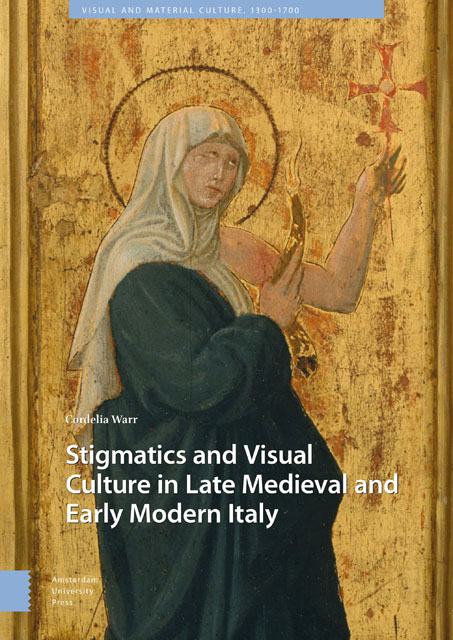Book contents
- Frontmatter
- Table of Contents
- Acknowledgements
- List of Illustrations
- 1 Introduction: Stigmata and Visual Culture
- 2 Saint Francis of Assisi as Image
- 3 Representing the Invisible: Saint Catherine of Siena’s Stigmatization
- 4 The Stigmatic Spectrum and the Visual Arts
- 5 Gregorio Lombardelli, Invisibility, and the Representation of Saint Catherine of Siena’s Stigmata
- 6 Performing Stigmata
- 7 Painting, Printing, Sculpting, Forgery (and Washing)
- 8 Conclusion: The Timidity of the Visual Arts
- Complete Bibliography
- Index
4 - The Stigmatic Spectrum and the Visual Arts
Published online by Cambridge University Press: 06 December 2022
- Frontmatter
- Table of Contents
- Acknowledgements
- List of Illustrations
- 1 Introduction: Stigmata and Visual Culture
- 2 Saint Francis of Assisi as Image
- 3 Representing the Invisible: Saint Catherine of Siena’s Stigmatization
- 4 The Stigmatic Spectrum and the Visual Arts
- 5 Gregorio Lombardelli, Invisibility, and the Representation of Saint Catherine of Siena’s Stigmata
- 6 Performing Stigmata
- 7 Painting, Printing, Sculpting, Forgery (and Washing)
- 8 Conclusion: The Timidity of the Visual Arts
- Complete Bibliography
- Index
Summary
Abstract
Tommaso Caffarini's Libellus de Supplemento supported and promoted Catherine of Siena's cult by discussing Catherine as a stigmatic, advocating the correct way of representing her stigmatization, and placing her within the context of the phenomenon of stigmata. In Tractatus VII Caffarini argued for an expanded interpretation of stigmata. This chapter explores his discussion of what I term a spectrum of stigmatic symptoms and behaviours and how these were represented in the manuscript of the Libellus in Siena. I argue that the stigmatic spectrum was consciously promoted in some fifteenth-century Dominican panel paintings and that particular images were also reflexive in their use of the depiction of paintings and sculptures, focusing attention on the interconnectivity of stigmatic experience and visual culture.
Keywords: stigmatic spectrum, Catherine of Siena, Tommaso Caffarini, Dominicans, Libellus de Supplemento
In his Libellus de Supplemento (Supplement to the Life of Catherine of Siena), Tommaso Caffarini placed Catherine of Siena within the wider context of stigmatization, providing an extended discussion of stigmata and how they could be defined. Countering claims that Saint Francis of Assisi was the only true stigmatic, he argued for an expanded understanding of stigmata in direct opposition to the restricted Franciscan definition of the term. Caffarini stressed that it could relate to the reception of all or some of the wounds received by Christ during his Passion, not just the wounds received on the cross, and that true stigmatization was not purely a miraculous phenomenon. His argument was accompanied in the manuscripts, now held in Siena and Bologna, by a series of ink illustrations, in addition to the full-page image of four stigmatics discussed in the previous chapter. Following an exploration of Caffarini's discussion of what I term a spectrum of stigmatic symptoms and behaviours, and how these were represented in the Siena manuscript of the Libellus (Siena, Biblioteca Comunale degli Intronati, MS Segn. T.I.2), this chapter considers some Dominican panel paintings of the fifteenth century. I argue that these consciously promoted the stigmatic spectrum, encouraging the viewer to consider the different ways in which it was possible to participate in Christ's suffering.
- Type
- Chapter
- Information
- Publisher: Amsterdam University PressPrint publication year: 2022



